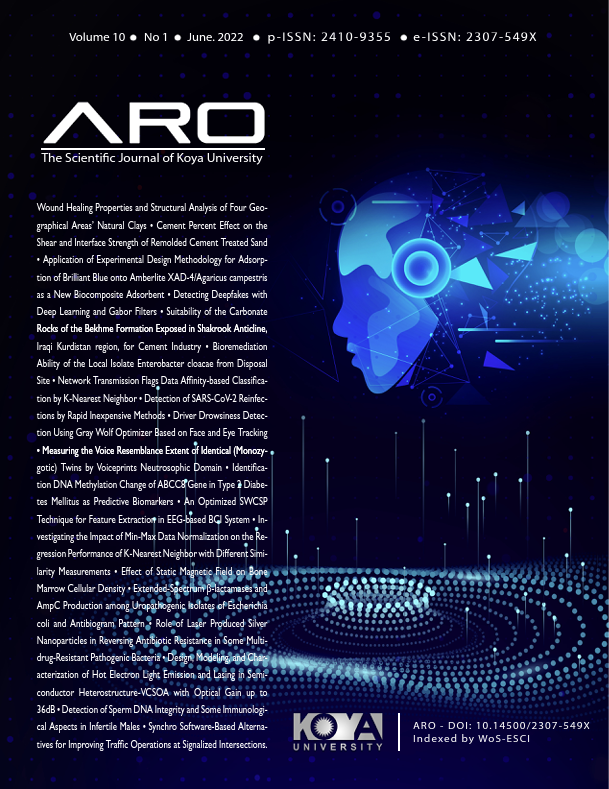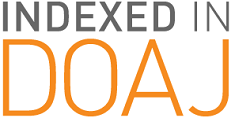Detection of SARS-CoV-2 Reinfections by Rapid Inexpensive Methods
DOI:
https://doi.org/10.14500/aro.10916Keywords:
Alpha variant, Iraq, Reinfections, Reinfections, SARS- CoV-2Abstract
New SARS-CoV-2 infections are difficult to beverified, whether they are reinfections or persistent infections. The most prominent factors used for differentiating reinfections from persistent infections are whole-genome sequencing and phylogenetic analyses that require time and funds, which may not be feasible in most developing countries. This study explores reinfections with COVID-19 that harbors D614G and N501Y mutations by rapid inexpensive methods. It exploits the previously developed rapid economic methods that identified both D614G and N501Y mutations in clinical samples using real-time reverse transcriptase polymerase chain reaction (rRT-PCR) probes and conventional PCR specific primers. In the present study, an immunocompetent patient has been found with a SARS-CoV-2 N501Y reinfection without comorbidities. According to the obtained results, this study suggests that the initial infection was due to a variant that contained only D614G mutation whereas the reinfection was potentially a result of alpha variant contained three mutations confirmed by DNA sequencing, including D614G, N501Y, and A570D mutations. These techniques will support rapid detection of SARS-CoV-2 reinfections through the identification of common spike mutations in the developing countries where sequencing tools are unavailable. Furthermore, seven cases of reinfections were also confirmed by these methods. These rapid methods can also be applied to large samples of reinfections that may increase our understanding epidemiology of the pandemic.
Downloads
References
Al-Jaf, S.M.A., Niranji, S.S., 2021. Rapid detection of SARS CoV-2 N501Y mutation in clinical samples. medRxiv 2021, p.21255656.
Al-Jaf, S.M.A., Niranji, S.S., and Mahmood, Z.H., 2021. Rapid, inexpensive methods for exploring SARS CoV-2 D614G mutation. Meta Gene, 30, p. 100950.
Banada, P., Green, R., Banik, S., Chopoorian, A., Streck, D., Jones, R., Chakravorty, S., Alland, D., 2021. A simple RT-PCR melting temperature assay
to rapidly screen for widely circulating SARS-CoV-2 variants. MedRxiv, 2021, p.21252709.
Brehm, T.T., Pfefferle, S., von Possel, R., Kobbe, R., Nörz, D., Schmiedel, S., Grundhoff, A., Olearo, F., Emmerich, P., Robitaille, P., Günther, T., Braun, P.,
Andersen, G., Knobloch, J.K., Addo, M.M., Lohse, A.W., Aepfelbacher, M., Fischer, N., Wiesch, J.S.Z., and Lütgehetmann, M., 2021. SARS-CoV-2 reinfection in a healthcare worker despite the presence of detectable neutralizing antibodies. Viruses, 13(4), p. 661.
CDC, 2020. Common Investigation Protocol for Investigating Suspected SARS-CoV-2 Reinfection. Available from: ttps://www.cdc.gov/coronavirus/2019-ncov/php/reinfection.html#print [Last accessed on 2021 May 05].
CDC, 2022. Altered Immunocompetence. Available from: https://www.cdc.gov/vaccines/hcp/acip-recs/general-recs/immunocompetence.html [Last accessed on 2022 Mar 15].
Challen, R., Brooks-Pollock, E., Read, J.M., Dyson, L., Tsaneva-Atanasova, K., and Danon, L., 2021. Risk of mortality in patients infected with SARS-CoV-2 variant of concern 202012/1: Matched cohort study.BMJ, 372, p.n579.
Choudhary, M.C., Crain, C.R., Qiu, X., Hanage, W., and Li, J.Z., 2021. SARS-CoV-2 sequence characteristics of COVID-19 persistence and reinfection. MedRxiv, 2021, p.21252750.
Costa, A.O.C., de Carvalho Aragão Neto, H., Nunes, A.P.L., de Castro,R.D., 2021. Covid-19: Is reinfection possible?. EXCLI Journal, 20, pp.522-536.
Davies, N.G., Jarvis, C.I., Edmunds, W.J., Jewell, N.P., Diaz-Ordaz, K., and Keogh, R.H., 2021. Increased mortality in community-tested cases of SARS-CoV-2 lineage B.1.1.7. Nature, 593(7858), pp.270-274.
Durner, J., Burggraf, S., Czibere, L., Tehrani, A., Watts, D.C., and Becker, M., 2021. Fast and cost-effective screening for SARS-CoV-2 variants in a routine diagnostic setting. Dental Materials, 37(3), pp.e95-e97.
Falahi, S., and Kenarkoohi, A., 2020. COVID-19 reinfection: Prolonged shedding or true reinfection? New Microbes and New Infections, 38, p.100812.
Graham, M.S., Sudre, C.H., May, A., Antonelli, M., Murray, B., Varsavsky, D., Kläser, K., Canas, L.S., Molteni, E., Modat, M., Drew, D.A., Nguyen, L.H., Polidori, L., Selvachandran, S., Hu, C., Capdevila, J., Hammers, A., Chan, A.T., Wolf, J., Spector, T.D., Steves, C.J., and Ourselin, S., 2021. Changes in symptomatology, reinfection, and transmissibility associated with the SARS-CoV-2 variant B.1.1.7: An ecological study. The Lancet Public Health, 6(5), pp.e335-e345.
Hansen, C.H., Mumoli, N., Clerici, P., De Paschale, M., Evangelista, I., Cei, M., and Mazzone, A., 2021. Assessment of protection against reinfection with SARS-CoV-2 among 4 million PCR-tested individuals in Denmark in 2020: A population-level observational study. Lancet, 397(10280), pp.1204-1212.
Hussein, N.R., Musa, D.H., Ibrahim, N., Saleem, Z.S.M., and Naqid I.A., 2021. COVID-19 Reinfection in a Nurse Working in Emergency Hospital in Duhok City, Kurdistan Region of Iraq. Asian Journal of Case Reports in Medicine and Health, 5(1), pp.27-30.
Hussein, N.R., Musa, D.H., Saleem, Z.S.M., Naqid, I.A., and Ibrahim, N., 2020. The first case of COVID-19 reinfection in Duhok city, Kurdistan region of Iraq: A case report. Journal of Kermanshah University of Medical Sciences, 24(4), p.111454.
Marquez, L., Koy, T., Spinler, J.K., Luna, R.A., Tocco, L., Fasciano, L., Dunn, J. and Campbell, J.R., 2021. Reinfection with severe acute respiratory syndrome coronavirus 2 (SARS-CoV-2) B. 1.1. 7 variant in an immunocompromised adolescent. Infection Control and Hospital Epidemiology, 1-2, pp.1-6.
Mukherjee, A., Anand, T., Agarwal, A., Singh, H., Chatterjee, P., Narayan, J., Rana, S., Gupta, N., Bhargava, B., Panda, S., 2021. SARS-CoV-2 re-infection: Development of an epidemiological definition from India. Epidemiology and Infection, 149, p.e82.
Novazzi, F., Baj, A., Genoni, A., Spezia, P.G., Colombo, A., Cassani, G., Zago, C., Pasciuta, R., Gasperina, D.D., Ageno, W., Severgnini, P., Dentali, F., Focosi, D., and Maggi, F., 2021. SARS‐CoV‐2 B.1.1.7 reinfection after previous Covid‐19 in two immunocompetent italian patients. Journal of Medical Virology, 93(9), pp.5648-5649.
Parry, J., 2020. Covid-19: Hong Kong scientists report first confirmed case of reinfection. BMJ, 370. p.m3340.
Qureshi, A.I., I Baskett, W., Huang, W., Lobanova. I., Naqvi, S.H., and Shyu, C.R., 2021. Re-infection with SARS-CoV-2 in patients undergoing serial laboratory testing. Clinical Infectious Diseases, 74(2), pp.294-300.
Ramírez, J.D., Muñoz, M., Ballesteros, N., Patiño, L.H., Castañeda, S., Rincón, C.A., Mendez, C., Oliveros, C., Perez, J., Márquez, E.K., de Los Santos Ortiz, F., Correa-Cárdenas, C.A., Duque, M.C., and Paniz-Mondolfi, A., 2021.
Phylogenomic evidence of reinfection and persistence of sars-cov-2: First report from Colombia. Vaccines, 9(3), p.9030282.
Sandoval Torrientes, M., Abietar, C.C., Riveiro, J.B., Álvarez-Argüelles, M.E., Rojo-Alba, S., Salinas, F.A., González, I.C., Martínez, Z.P., Rodríguez, G.M., de Oña, J.G., García, E.C., and García, S.M., 2021. A novel single nucleotide polymorphism assay for the detection of N501Y SARS-CoV-2 variants. Journal of Virological Methods, 294, p.114143.
Simmonds, P., Williams, S., and Harvala, H., 2021. Understanding the outcomes of COVID-19-does the current model of an acute respiratory infection really fit? The Journal of General Virology, 102(3), p001545.
Staub, T., Arendt, V., de la Vega, E.C.L., Braquet, P., Michaux, C., Kohnen, M., Tsobo, C., Abdelrahman, T., Wienecke-Baldacchino, A., and Francois, J.H., 2021. Case series of four re-infections with a SARS-CoV-2 B.1.351 variant, Luxembourg, February 2021. Euro Surveillance, 26(18), p.2100423.
Stokel-Walker, C., 2021, What we know about covid-19 reinfection so far. The BMJ, 372, pp.1-2.
Weigang, S., Fuchs, J., Zimmer, G., Schnepf, D., Kern, L., Beer, J., Luxenburger, H., Ankerhold, J., Falcone, V., Kemming, J, Hofmann, M., Thimme, R., Neumann-Haefelin, C., Ulferts, S., Grosse, R., Hornuss, D., Tanriver, Y., Rieg, S., Wagner, D., Huzly, D., Schwemmle, M., Panning, M., and Kochs, G., 2021. Within-host evolution of SARS-CoV-2 in an immunosuppressed COVID-19 patient as a source of immune escape variants. Nature Communications, 12(1), p.6405.
Downloads
Published
How to Cite
Issue
Section
License
Authors who choose to publish their work with Aro agree to the following terms:
-
Authors retain the copyright to their work and grant the journal the right of first publication. The work is simultaneously licensed under a Creative Commons Attribution License [CC BY-NC-SA 4.0]. This license allows others to share the work with an acknowledgement of the work's authorship and initial publication in this journal.
-
Authors have the freedom to enter into separate agreements for the non-exclusive distribution of the journal's published version of the work. This includes options such as posting it to an institutional repository or publishing it in a book, as long as proper acknowledgement is given to its initial publication in this journal.
-
Authors are encouraged to share and post their work online, including in institutional repositories or on their personal websites, both prior to and during the submission process. This practice can lead to productive exchanges and increase the visibility and citation of the published work.
By agreeing to these terms, authors acknowledge the importance of open access and the benefits it brings to the scholarly community.
Accepted 2022-04-15
Published 2022-05-03
















 ARO Journal is a scientific, peer-reviewed, periodical, and diamond OAJ that has no APC or ASC.
ARO Journal is a scientific, peer-reviewed, periodical, and diamond OAJ that has no APC or ASC.